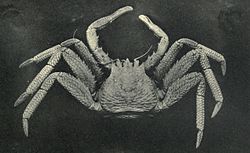| Placetron | |
|---|---|
 | |
| P. wosnessenskii female | |
 | |
| P. wosnessenskii under the sea anemone Cribrinopsis fernaldi | |
| Scientific classification | |
| Domain: | Eukaryota |
| Kingdom: | Animalia |
| Phylum: | Arthropoda |
| Class: | Malacostraca |
| Order: | Decapoda |
| Suborder: | Pleocyemata |
| Infraorder: | Anomura |
| Family: | Lithodidae |
| Genus: | Placetron Schalfeew, 1892 |
| Species: | P. wosnessenskii |
| Binomial name | |
| Placetron wosnessenskii Schlafeew, 1892 | |
| Synonyms [1] | |
| |
Placetron wosnessenskii, common name the scaled crab, is a species of king crab found in most waters off North America's west coast. It is the only species in the genus Placetron. [1]
